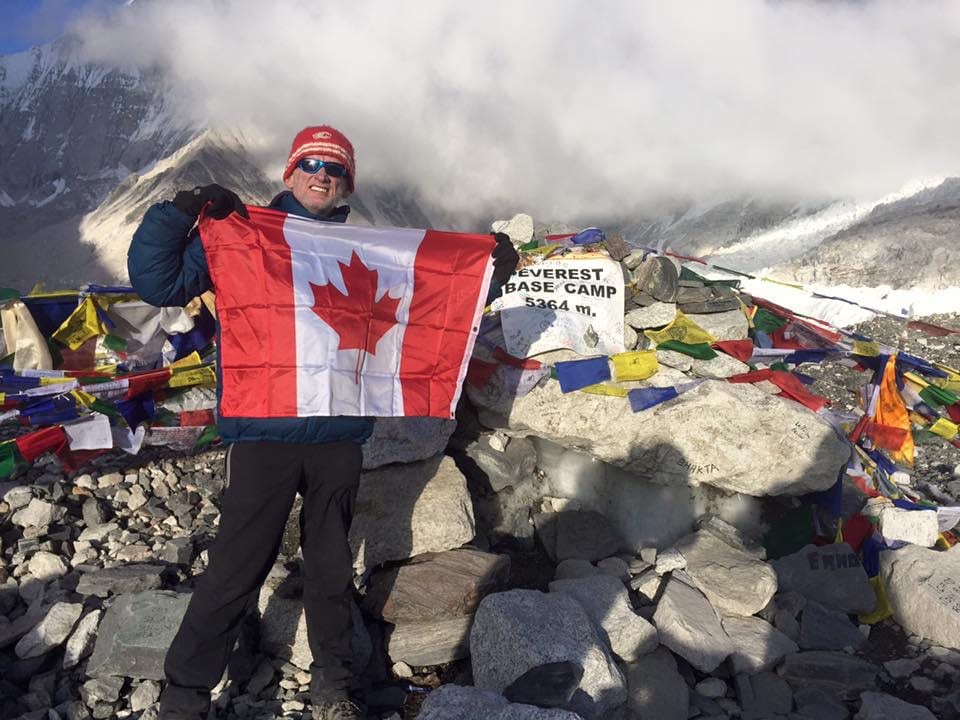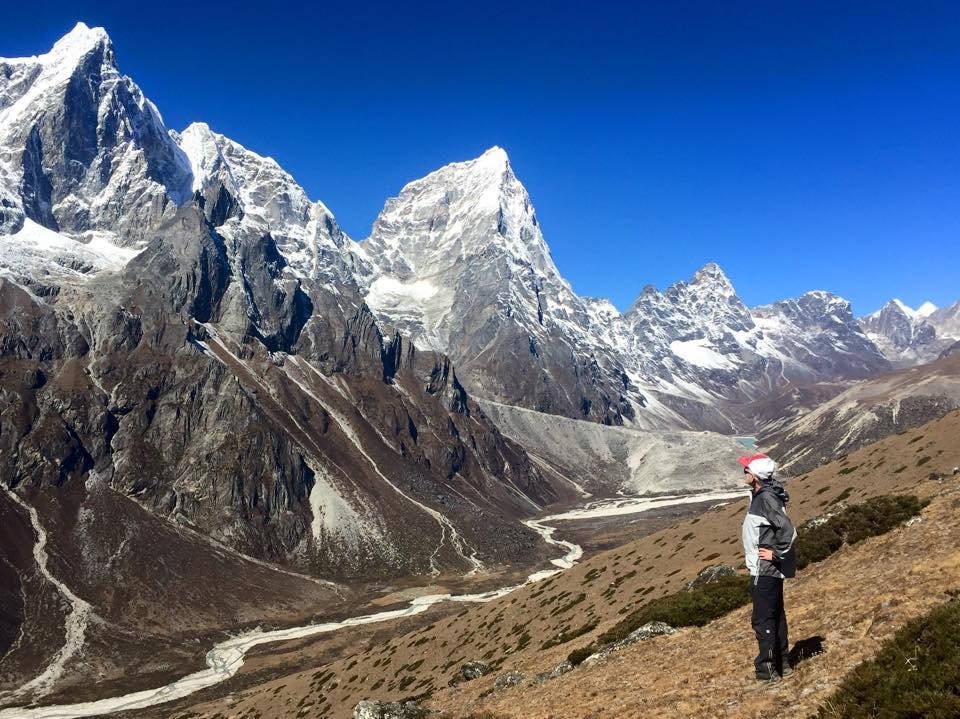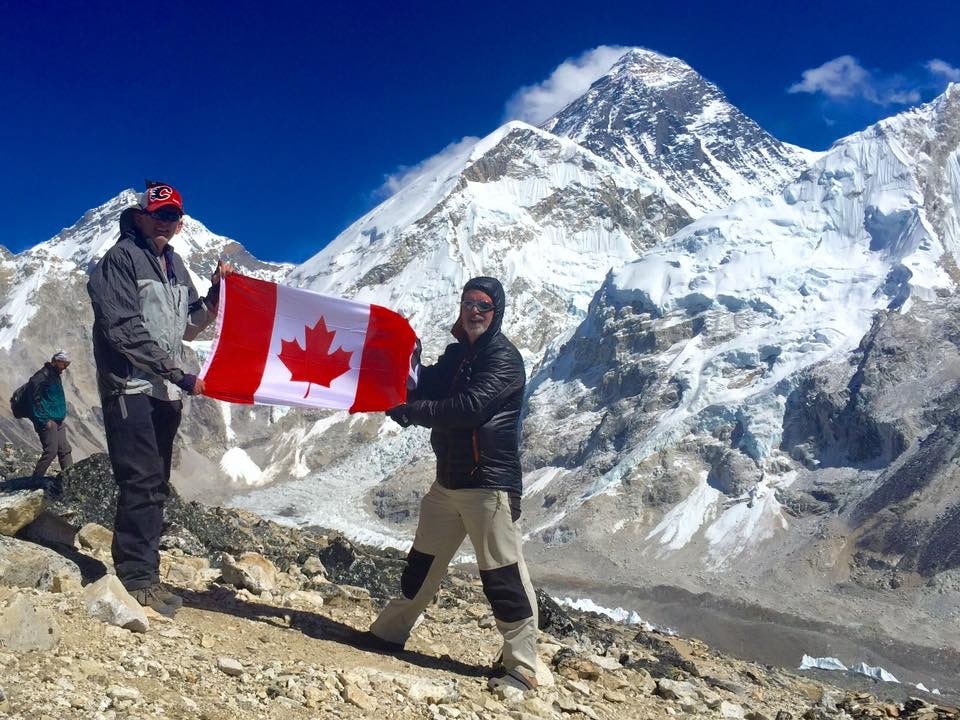MMy name is Kenn, from Calgary, Canada. I have a unique perspective on the Everest Base Camp Trek, having done the world famous hike twice in 2015. My first trekking experience was with Ian Taylor Trekking in April 2015. Additionally I trekked to Everest again in October 2015 to sleep at Everest Base Camp. This was all after the earthquakes that rocked Nepal in the spring.
My Dream of Seeing Mount Everest

A Great Set-Up
From the moment I exited the airport, Ian’s staff were there for transfers, tours and hotel check-ins. The first few hours in Kathmandu are somewhat a shock for people from western countries. However, after a while of wandering the bustling streets of the trekkers district of Thamel, you realize you are in a unique city. Kathmandu is wonderfully exotic and a very safe the city.
In April ours was a fairly large group of over twenty trekkers from several different countries. The group members quickly gelled over the first couple of days. We also had 5 yaks to transport our kit bags along the way.
A Lifelong Dream
Everyone had the goal of reaching Everest Base Camp. For many, it’s been a life long goal to stand in awe of Mount Everest. For all, the journey started months in advance with training hikes and various workout routines. Everyone was keenly aware we were going to very high altitude. The trek eventually reaches some of the highest elevations in the world, that can be achieved by the common hiker. The term ‘Nepali Flat’ is quickly instilled in us. The trail is rarely flat. You trek up a hill, you go down a hill, sometimes it may be just 30 meters, sometimes it may be several hundred metres. In fact, because you’re going up and down like a Yo-yo, the trek from start to finish has a total vertical rise of about 8,200m. This starts from from Lukla, to EBC all the way back to Lukla.
Physically Demanding Trek
Along the trek people have their individual strengths and weaknesses. Someone’s strength may be going up hills, while that may be someone’s else’s weakness. Ian’s years of experience as a group leader were priceless. Managing trekkers at altitude means that each individual’s capabilities and expectations were taken into account. Although a physically demanding trek. The pace was always such that we were not struggling or gasping for breath in the heights of the Himalaya. This was really important to manage fatique and group safety.

Reaching Namche Bazaar

The two day trek from Lukla to Namche starts with a meandering trail through many small villages along the Dhudh Kosi River. We crossed several suspension bridges, I think 9 to reach the high bridge below Namche Bazaar. Once the trail crosses into the Sagarmatha National Park, it is very rugged and a steep long trek to Namche Bazaar at 3,440 meters. Ian’s itineraries have a three night stay in Namche with two days of additional acclimation hikes high above the village. This allows your body to gradually compensate for less oxygen available. This is important because each day, each new lodge is higher and higher in elevation.
On the day that the group leaves Namche, a brief uphill section takes you to a fairly flat section of trail. This section of trail lasts for about four kilometres, then much of the elevation gained hiking up to Namche is lost. Too cross a river we have to drop down about 300m before we climb back up hill. You have lunch by the rover and hike up 700 meters of elevation to 3,900 meters at Tengbouche. I think most would consider this the longest and perhaps toughest hill climb on the EBC Trek.
Best Mountain Views in the World
The following day will took us to Dingbouche – and a dramatic change to the trek. Spectacular views of the peak of Everest are lost as the Nuptse ridge line dominates. The view north and Ama Dablam seemingly transforms from a picturesque beauty to a rugged glacial wonder. All this is seen as the trail climbs above tree line. Dingbouche is a two night stay for acclimation. A climb high above the village for the simple purpose of acclimation is the excuse for a view that will take your breath away. With nearly vertical mountains surrounding the group. The mountains where mostly above 6,000 meter and above in this area. It’s really an honour to acclimate at over 5,000 meters for a couple hours.

The hike the following day from Dingbouche to Lobuche is a stunning walk. It was time for our group to climb the Khumbu Glaciers terminal moraine. At the top of the moraine we reached the famed and haunting Stone Memorials. This area is dedicated to many of the climbers who have lost their lives while climbing Mount Everest. The final section to Lobuche is when your goal of reaching EBC is almost in site. We had stunning views of Pumori and Khumbutse dominating the north.
Deep Snow Stopped us Moving Forward
After a very chilly night at nearly 5,000 metres at Lobuche. Our group awakened to nearly 30 centimetres of freshly fallen snow on the ground. This, obviously, is not good. The high elevation trails of Nepal must be respected as the weather and natural surroundings can be very unforgiving. On this day, Ian and his team are in contact with expedition teams and weather forecasters at EBC; the long term predictions are for snow for the next four consecutive days. It is at this time that Ian makes the decision that it is too dangerous to continue. No Gorak Shep and EBC.
With a poor long term forecast, full lodges, domestic and international travel arrangements. It was time for our group to retreat to a lower village. Our new goal was the village of Pheriche where the weather was more manageable. My EBC dream was over for now. The group is in 100% agreement that this is the right decision: safety is the number one priority. For most, it will still be the trip of a life time. This was the first time any of Ian’s EBC treks were not able to make it to EBC. Our group became known among ourselves as the ‘Almost EBCers’!
The Beautiful Town of Pokhara
After arriving back in Kathmandu, I had a few days available. I had pre-planned for a side trip to the resort city of Pokhara. Ian’s assistant Dawa arranged flights, transfer and a hotel for me and all went off without a hitch. I was able to Para-glide and zip line in Pokhara. Upon return to Kathmandu, I left the next day for Hong Kong. This was just two days before the April 25th earthquake struck Nepal! Everyone has seen the news reports of swaying buildings and collapsing temples in Kathmandu. This was incredibly worrying, knowing some our our team were still in Nepal. Coupled with the thousands that lost their lives in a battered country with a third world economy and infrastructure.

The Goal of Returning to Nepal
Early after returning home, I made commitment to myself that I would return to Nepal. I waited well into the summer season to chose a return date. With the earthquake and aftershocks still happening, I needed to make a decision. The monsoon season approaching, there was a lot of uncertainty regarding the EBC trail’s status.
Sleeping at Everest Base Camp
With news of a good Everest Base Camp trail I made contact with Ian once again. I decided that the October departure (one that actually spent the night at EBC) was for me. After all, I’m a Canadian – a little cold camping on a glacier was not a worry.
So, in early October, I landed in Kathmandu with a curiosity of what I would see in the city. Just a few short months before, was the centre of the world’s newscasts due to the April and May earthquakes. The sites where buildings had collapsed had been cleared, and no roads were blocked. Much of the fallen materials were being recycled. In Nepal, virtually everything will be reused in some way. In the streets of Thamel, the only thing missing were the tourists; business was down by up to 80%, all because of the negative images of the earthquakes. The shops were full of merchandise, and the restaurants waiting for diners.

A Smaller Team
There would only be two of us on this particular EBC trek (aside from our Sherpa guide and Sherpa porter). My trekking partner would be John from Ireland. John had timed the trip so that he would wake up at EBC on the morning of his 50th Birthday. Read more about John’s story HERE. Pasang would be our guide and Kancer Rai our porter who we would meet in Lukla.
Earthquake Damage?
The Journey up Kala Patthar
In the morning in Lobuche, I woke up about 6:00 am and looked out the frosted window to a full blue sky. The hike to Gorak Shep took about 3 hours, with some vertical hiking and a lot of loose rock as we were climbing along the lateral moraine of the Khumbu Glacier. At this elevation, regardless of exertion (or lack thereof), you’re pretty pooped. With it still being a blue sky upon arrival in Gorak Shep. We decided to tackle the climb up Kala Patthar that afternoon for the sunset view of Mount Everest.
Kala Patthar is really a lower ridge of Pumori. If you hike and reach the flags at the top, you’ll be at about 18,520 feet, or, 5,645 meters. Kala Phattar is the highest point on the EBC Trek. The views across the Khumbu Glacier to Everest and Nuptse are spectacular. The last hundred or so metres are very rocky, with some climbing around boulders. The view from the top is certainly better than further down. You can still get suburb views of Mount Everest from about 2/3rds to the top.

Reaching my Everest Base Camp Dream

